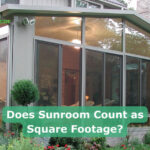Tired of battling mosquitoes on scorching summer days? A sunroom could be your sanctuary, a haven that lets you savor the outdoors without stepping outside. Whether you envision hosting sunlit events or immersing yourself in a book with a panoramic view, sunrooms offer a retreat shielded from sudden rain or unexpected gusts of wind.
Understanding the Essence of Sunrooms
A sunroom, an extension enveloped in windows or screens, often crowned with a glass roof, orchestrates a perpetual play of light. Yet, not all sunrooms are created equal.
Types of Sunrooms
Sunrooms transcend mere architectural appendages, offering flexible indoor/outdoor space that expands your home’s square footage and grants year-round access to sunshine. They come in various types, each catering to distinct preferences and budgets.
- Three-Season Sunroom
- Ideal for moderate climates, usable for three seasons.
- Separated from the main house, lacks climate control.
- Average cost: $10,000 to $40,000.
- Four-Season Sunroom
- Equipped with heating and cooling capabilities.
- Features knee-high walls for HVAC ducts and wiring.
- Utilizes insulated windows for temperature regulation.
- Average cost: $25,000 to $80,000.
- Sun Porch
- Enclosed by screens rather than windows.
- An affordable option, perfect for DIY projects.
- Average cost: $2,000 to $2,800.
- Conservatory
- Originally designed as greenhouses, covered in glass.
- Varies in cost based on size, architecture, and materials.
- Average cost: $5,000 to $80,000.
Pros and Cons of Adding a Sunroom
Pros
- Expands home value by increasing indoor/outdoor space.
- Provides a bug-free outdoor dining and hosting area.
- Enhances natural light within the home.
- Offers versatile use as a dining area, play space, or entertainment room.
- Generally costs less than other home additions.
Cons
- Average cost ranges from $21,000 to $73,000.
- Four-season sunrooms require additional insulation and HVAC, elevating costs.
- Three-season sunrooms are unusable for a quarter of the year.
- May encroach on outdoor yard space.
- More exposed to the elements, susceptible to temperature changes, leaks, and storm damage.
Choosing the Right Sunroom Style
As you navigate the myriad sunroom styles, key considerations come into play. Ask yourself:
- Budget: Determines the type and size of your sunroom, with sun porches being more budget-friendly and four-season rooms pricier.
- Intended Use: Tailor your choice based on whether it’s for year-round activities, entertaining, or gardening.
- Climate: Consider the climate of your area; a four-season room suits colder regions, while a conservatory may be uncomfortable in hot climates.
- Home Design: Align the style with your existing home design, ensuring visual cohesion.
Custom Sunroom Features
Beyond styles, customization options let you tailor your sunroom to exact preferences:
- Fireplaces: Add warmth and ambiance.
- Wet Bar: Elevate entertainment options.
- Privacy Shades: Control sunlight and visibility.
- Built-in Entertainment System: Integrate technology seamlessly.
Is a Sunroom a Good Fit for Me?
A sunroom proves ideal for those who:
- Appreciate light, airy spaces.
- Have a budget aligning with their sunroom of choice.
- Live in an HOA-friendly neighborhood or an area allowing sunroom additions.
- Enjoy indoor/outdoor living year-round.
Additional Sunroom Considerations
- Design Elements: Plan electrical outlets, lighting fixtures, custom features, and plant integration.
- Location: Choose thoughtfully; westward-facing for afternoon warmth, eastward for morning light, and south/north-facing for consistent brightness.
- DIY vs. Professional: Assess the complexity; DIY for prefabricated kits or hire professionals for ground-up construction.
FAQs
- Purpose of a Sunroom: A sunroom adds an indoor space to rest, dine, or host, with floor-to-ceiling windows creating a bright yet protected atmosphere.
- Sunrooms as Living Space: Properly insulated sunrooms with electrical and HVAC access count as living space, affecting a home’s square footage.
- Value Addition: Sunrooms add value, with insulated four-season rooms contributing more than three-season or exterior spaces.
Conclusion
The allure of sunrooms lies not just in their aesthetic charm but in the limitless possibilities they offer. A well-considered sunroom enhances your home’s value, blurs the boundaries between indoor and outdoor living, and becomes a cherished retreat for every season. As you embark on this transformative addition, let the sun illuminate not just your space but your lifestyle.



